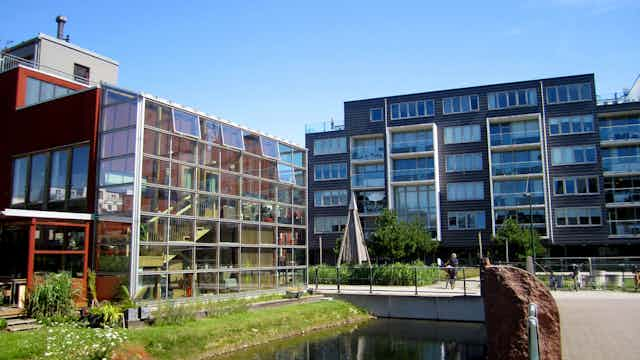While governments and nations are deadlocked in negotiations to reduce carbon emissions and prevent catastrophic warming, some cities are quietly turning over to renewable energy.
Sydney was the first Australian city to claim carbon neutrality in 2008, using offsets and Green Power. It aims to source all its energy from renewable sources by 2030. So, when it comes to cutting carbon, are cities the place to start?
There have been calls for Australian local government to promote low-carbon cities, especially since global levels of CO2 passed 400 ppm.
There are good reasons for aiming carbon-reduction at cities and local government. Local government can deal directly with households and small businesses in ways the state and federal government can’t. Local government has also proved to be an important source of program innovation.
But engaging Australia’s local governments is easier said than done. Our councils are uncoordinated, underfunded and often lack the necessary expertise when it comes to environmental protection.
Perhaps we can look elsewhere for inspiration. Recent achievements by Swedish cities show how Australian cities could adopt low-carbon initiatives.
A Swedish smörgåsbord
Three Swedish cities offer insights into how local government can approach low-carbon policies: through energy and electricity, public transport, and urban planning.
Växjö
Växjö was named Europe’s best climate city by the European Commission in 2007. It has reduced CO2 emissions by 41% per person between 1993 and 2012. The savings came from producing local government district heating (which accounts for 90% of the city’s energy use) and by generating half the city’s electricity from forestry waste.
The emissions cut was achieved by replacing fossil fuel energy sources (oil and gas) with biomass in the city’s combined heat and power plant. Forestry waste is a renewable source of energy and does not release any more CO2 than the natural biodegradation of the waste (though at a faster rate than occurs naturally).
Växjö is also working to reduce overall energy consumption for local government, households and businesses (through retrofits and information provided by local government energy advisors).

Örebro
The city of Örebro is converting all its public transport to biogas. The biogas is sourced from the sewage treatment plant and by collecting fugitive emissions from landfills. All city buses are now running on biogas, reducing CO2 emissions by 15,000 tonnes per year. This is equivalent to taking 7,000 cars off the road. Biogas production is being increased so that all municipal transport can use this alternative fuel. Örebro’s eventual aim is to facilitate the transition of private transport to biogas by supporting a growing biogas market.
Malmö
Malmö’s old industrial Western Harbour was redeveloped to focus on low-carbon energy production and transport. When its shipyard was closed, plans were made for a new city precinct to include 100% renewable energy and with bikes and walking as the main modes for transport.
Redevelopment is an important component in urban low carbon transitions. Planning regulation can do more to guide energy production and transport for new housing than it can in existing areas.
How do cities fit into the big picture?
Sweden has among the lowest greenhouse gas emissions in the European Union and OECD. Preliminary figures show that Swedish emissions in 2012 were almost a fifth lower than in 1990.
This achievement is partly explained by an ambitious climate policy: Sweden aims to reduce its emissions 40% from the 1990 levels by 2020 and then to reach the objective of zero net emissions of GHGs by 2050. Low-carbon cities will be central to this goal.
In the Swedish system local government has substantial financial, constitutional, legal, political and professional resources.
A significant development came in the 1950s and 1970s, when the number of local governments was reduced from 2500 to 290 today. This enabled local government to assume greater responsibilities and increase overall service delivery, including local environmental policy and planning.
Challenges for Australia
Australia’s long-term goal is to reduce emissions by 80% below year 2000 levels by 2050, the same goal as the EU. Achieving this goal will necessitate a major transformation: the vast majority of Australian local governments have not been either widely or deeply engaged in promoting low-carbon cities.
Australian local government faces the challenge of whole-of-city planning and implementation. Also, environmental protection is a largely unfunded mandate for local government. Scarce resources also restrict the opportunities for employing trained and expert staff.
Swedish environmental policy isn’t perfect, and some might regard these examples as transition technologies, rather than paradigmatic change. Certainly Australia isn’t in a position to adopt Sweden’s model of local government with its substantial resources and autonomy, but there are lessons for Australia in coordinating its efforts, using expertise, and policy innovation to promote low-carbon cities.

